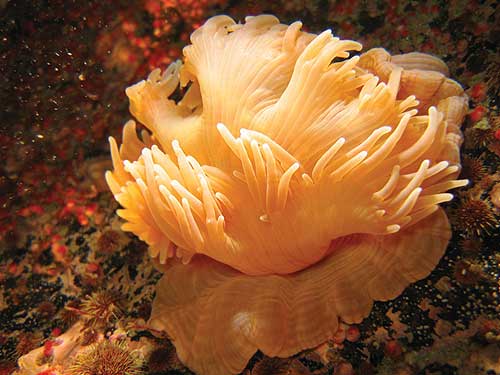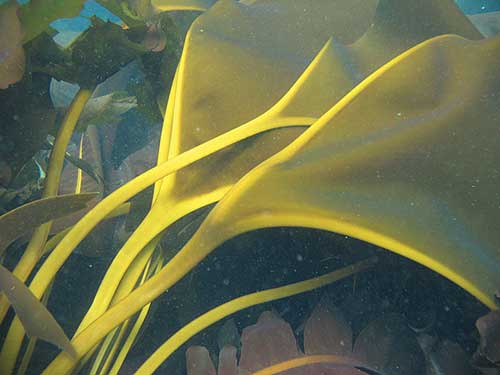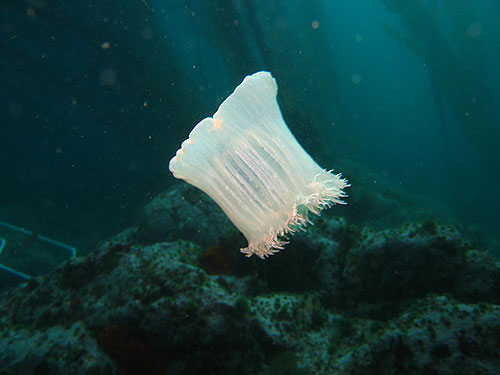 November 02, 2007
This summer, while completing the second phase of a two-year broad scientific survey of the waters around the Aleutian Islands, scientists have discovered what may be three new marine organisms. This year's dives surveyed the western region of the Aleutians, from Attu to Amlia Island, while last year's assessment covered the eastern region.  Photo courtesy of Stephen Jewett
Another new species is a kelp or brown algae that scientists have named the "Golden V Kelp" or Aureophycus aleuticus. According to Mandy Lindeberg, an algae expert with NOAA's National Marine Fisheries Service and a member of the expedition, the kelp may represent a new genus, or even family, of the seaweed. Up to ten feet long, the kelp was discovered near thermal vents in the region of the Islands of the Four Mountains. "Since the underwater world of the Aleutian Islands has been studied so little, new species are being discovered, even today," said Jewett. He adds that even more new species may be revealed as samples collected during the dives continue to be analyzed. The organisms were found while surveying more than 1000 miles of rarely-explored coastline, from Attu to the Tigalda Islands. Logging more than 300 hours underwater, the divers collected hundreds of water, biological and chemical samples during 440 dives. Armed with underwater cameras and video cameras, the divers took hundreds of photographs and dozens of short movies of the creatures that inhabit the coast of the Aleutians. According to Jewett, the scientists are reasonably sure that the kelp is a new species, but more work is being done to confirm that the sea anemone species are completely new to science. Correspondence with anemone experts has, so far, shown the anemones to be new species, but the analysis is ongoing.  Photo by Max Hoberg During both years, the chief scientist on the project was Douglas Dasher, a water quality expert from the Alaska Department of Environmental Conservation. The scientific team operated from the R/V Norseman, a 108-foot vessel originally designed for crab fishing in the Bering Sea. The dives were part of a broad health assessment of the Aleutian Islands and were sponsored by the Alaska Environmental Monitoring and Assessment Program, also referred to as AKMAP. The program is funded by the Environmental Protection Agency and managed through a joint agreement between the ADEC and UAF. Samples from the dives are being used to catalog biodiversity in the region, assess water quality and potential contaminants. According to Jewett, this is the first time the remote nearshore region of the Aleutian Chain has undergone an in-depth marine assessment. Not immune from human impacts The rugged and remote islands of the Aleutians are not immune to the reach of human activity, say scientists leading the expedition. "Pollutants traveling through air and water pathways from temperate latitudes have been showing up in the area," says Jewett. "Debris and spills from World War II in the Aleutians have left their mark behind in unexploded ordinance and local sources of pollutants." Scientists on the project are using water and tissue samples collected during the dives to gauge the impacts of human activity in the area. Samples are being tested for nutrient and oxygen levels in the water, acidity, temperature and radioactive chemicals left over from the underwater nuclear tests conducted at Amchitka Island between 1965 and 1971.  Photo by Heloise Chenelot
Jewett, Dasher and the other scientists on the expedition hope that this assessment will help scientists gauge the overall health of the Aleutian Islands, both to provide a baseline for future comparison and to provide a general evaluation of the region's marine conditions. A unique diving experience Diving to a maximum depth of 60 feet along 1000 miles of mostly uninhabited coastline is an extraordinary experience, says Jewett. "This is my fourth diving mission in the Aleutians," said Jewett. "In my view, it's the best cold-water diving experience in the Northern Hemisphere, because of the outstanding visibility, coupled with the diverse and colorful marine life." UAF divers on the expedition included Reid Brewer, marine advisory program agent in Unalaska; Max Hoberg, marine taxonomist; Heloise Chenelot, research technician; and Shawn Harper, a graduate student studying marine biology. ADEC scientists included Jim Gendron, Terri Lomax and Nic Dallman. Other members of the scientific team included Roger Clark, a marine taxonomist with NOAA, and Roger Deffendall, a volunteer diver from Unalaska. The Aleutian Islands dives support the National Coastal Assessment Program, a nationwide project to characterize the U.S. nearshore coastline. AKMAP methods provide a practical, cost-effective system to characterize Alaska's coastal and surface waters. The AKMAP team has already sampled the marine waters off of Alaska's southcentral and southeastern coasts. The western Aleutians section of the program is the fourth of five planned surveys to assess Alaska's entire coastline.
On the Web:
Source of News:
Publish A Letter in SitNews Read Letters/Opinions
|